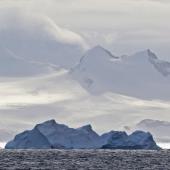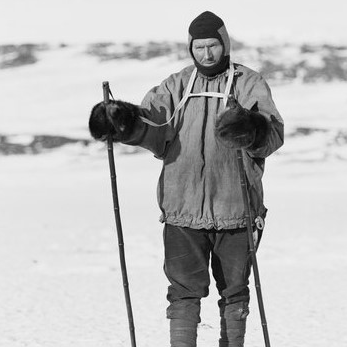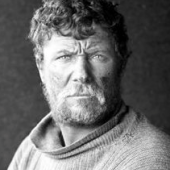On the first of December 1959, representatives from 12 countries came together in Washington D.C. to sign the Antarctic Treaty. This document guaranteed that the Antarctic region could only ever be used for scientific research, wherein all findings would be shared openly with other nations, and also that Antarctica could never be used for any means other than peaceful ones.

Though some of the signatory nations had previously made claims on the land in Antarctica, the Treaty makes it impossible for any of these claims to be recognised, and instead Antarctica is a region which belongs to none but is for the furtherment of scientific knowledge for all. The Irish played a significant role in developing our early knowledge of Antarctica. Let us look back at the legacy of three men from Cork who aided in the discovery and exploration of the vast Antarctic region.
Edward Bransfield was born in 1785 in the village of Ballinacurra in County Cork. Born into a well-respected family, Edward was denied access to an education as the Penal Laws were in effect in Ireland at the time. At the age of 18, Edward began his career in the Royal Navy. There are some sources that claim that he was taken against his and his father’s will in an act of impressment wherein young men were forced into military service. Regardless of how his naval career began, Edward soon proved his worth as an accomplished seaman. He served on a number of gun ships and eventually earned the title of Master of his own ship.
In January 1820, Edward was commissioned as part of a south bound voyage of discovery. On this journey, he landed on King George Island and turning South from there passed through what is now known as the Bransfield Strait. At this point, he recorded seeing the Trinity Peninsula, which we now know to be the most Northerly point of Antarctica. Edward kept meticulous notes when out on voyage and his description of “two high mountains, covered with snow” is generally accepted as the first recorded sighting of the Antarctic Continent. One of these “high mountains” has since been named Mount Bransfield in his honour. Edward then continued to chart the Trinity Peninsula following a route to the North-East.
Edward made a number of other Antarctic discoveries, including Elephant Island and Clarence Island. His contribution to the age of Antarctic exploration is immense as without his first sighting of the great frozen region, there may never have been any further interest in navigating southwards. Edward is remembered by a number of landmarks in Antarctica bearing his name, and also by a monument dedicated to his memory which will be unveiled in Ballinacurra in January 2020.
Robet Forde was born on the 29th of August 1875 in Moviddy in County Cork. Interested in seafaring from a young age, Robert joined the Royal Navy at the young age of 16. A talented seaman, Robert quickly rose through the ranks to eventually achieve the title of Petty Officer First Class. His dedication to his work and his diligent attention to detail saw him gain the attention of a number of naval officers.
On the 16th of April, at the age of 35, Robert volunteered to take part in Captain Scott’s ill-fated Terra Nova expedition to Antarctica. His role on the mission was as Petty Officer First Class whilst they were at sea, and whilst moored he was largely involved in the important task of depot laying. He was also involved in some of the survey work alongside geologists and physicists. This work involved spending a large amount of time away from the ship, at one stage he spent as much as six weeks investigating three glaciers on Ross Island. He also went away from the ship to check that the supplies in the depots were all still in good order. All this time out in the harsh Antarctic conditions took its toll on Robert, and he was eventually forced to return to the Terra Nova when he developed a severe case of frostbite in his hand. He was ordered to leave the expedition and instead returned to his naval career where he spent the rest of his years fighting in the war and eventually retiring back to his native Cork where it was remarked that he always wore a glove over his frostbitten hand.
Robert Forde’s contribution to the Terra Nova expedition was nothing short of essential. Without his diligence in laying the depots, there may have been many more lives lost on Scott’s race for the pole. He is remembered by a memorial on the promenade in Cobh where he spent his later years.
Patrick Keohane was born in Barry’s Point in Cork on the 2nd of June 1879. Patrick’s father worked on the local lifeboat, and it is often remarked that Patrick himself was a sailor from his very earliest years. At the age of 16, Patrick enlisted in the Royal Navy and began his sailing career in earnest. His dedication and skill spoke for themselves, and Patrick soon saw himself achieving the rank of Petty Officer.
When he was 30 years old, Patrick received a recommendation from none other than Robert Forde for a place on Captain Scott’s Terra Nova expedition. His role on this voyage was one of explorer, as Patrick was chosen to be one of the men who would engage in the race for the pole. He was, however, one of a group of men whom Scott sent back when he was merely 350 miles away from the highly sought after South Pole. Though he must have been irritated by Scott’s decision at the time, it was a move that would ultimately save Patrick’s life, as the men who carried on to the pole never made it home. As the weather conditions became increasingly difficult, it was soon realised that Scott and the remaining men were in dire peril. Patrick made an attempt to rescue his Captain, but was forced back to the Terra Nova by inclement weather. There he waited out the harsh Antarctic Winter before venturing out in the Spring to bring home the bodies of his fallen Captain and Compatriots. Patrick erected a wooden cross where he found the frozen bodies of Scott and his two remaining men.
Patrick’s bravery and his dedication to his captain were incredibly admirable. His memory is kept alive by a statue erected in his honour in Lislee Court
The contributions and sacrifices of these brave men from Cork are immense to say the least. They each played an essential role in an exciting age of discovery and exploration, and it is thanks to their efforts that we now have the scientific findings from the Antarctic region which are just as essential today as they were all those years ago.
Click on the images to learn more about the entries that inspired this Chronicles Insight.
Edward Bramsfield
Robert Forde
Patrick Keohane
Add your ancestor to the XO Chronicles
This Insight has been produced with support received from the Heritage Council.
We hope you have found the information we have shared helpful. While you are here, we have a small favour to ask. Ireland Reaching Out is a non-profit organisation that relies on public funding and donations to ensure a completely free family history advisory service to anyone of Irish heritage who needs help connecting with their Irish place of origin. If you would like to support our mission, please click on the donate button and make a contribution. Any amount, big or small, is appreciated and makes a difference.




